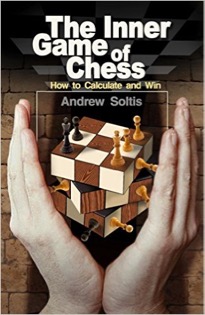Inner Game of Chess, The
Andy Soltis

One of the pioneering works on the art of calculating, THE INNER GAME OF CHESS by Andy Soltis appeared to excellent reviews in 1994. Now an updated and expanded edition of the original has been published by Mongoose Press.
The new edition includes not only very recent games such as Kamsky-Mamedyarov, World Cup 2013, and Carlsen-Anand, Moscow 2013, but much of the original work has been has been corrected and expanded. Every chess player knows the saying that chess is 99 percent tactics but Soltis holds, Chess is really 99 percent calculation the inner game of chess.
The table of contents gives the reader an idea of the contents of this book:
CHAPTER 1. What Calculation Is and Isnt …………………..5
The Myth of the Long Variations ………………………………………..8
Positional Players Dont Calculate …………………………………11
Calculation Means Finding Mates and Sacrifi ces …………….15
The Joys of Calculating ……………………………………………………19
Learning to Visualize ………………………………………………………23
CHAPTER 2. Ideas ………………………………………………………..29
Master vs. Novice …………………………………………………………..42
Looking for the Weakness ………………………………………………..50
Patterns ………………………………………………………………………52
Hints …………………………………………………………………………..54
CHAPTER 3. Trees and How to Build Them …………………..66
A Family of Ideas ……………………………………………………………70
Candidate Moves …………………………………………………………….74
The Tree of Analysis ……………………………………………………….82
How Chessplayers Really Think ……………………………………….88
CHAPTER 4. Force ………………………………………………………93
Let the Force ……………………………………………………………….97
Force vs. Speed, Force vs. Force …………………………………….100
Opening a Pandoras Box ……………………………………………….109
The Limits of Force ……………………………………………………….114
Force in Action ……………………………………………………………..116
CHAPTER 5. Counting Out ………………………………………….121
The Bottom Line …………………………………………………………..122
First Step: Count the Pieces ……………………………………………124
What Is Compensation? …………………………………………………136
Is it Over? …………………………………………………………………….140
Move Order ………………………………………………………………….154
Serendipity and Sequence ………………………………………………161
Orders and Options ……………………………………………………….163
Bailout …………………………………………………………………………168
Calculating in Stages ……………………………………………………..172
CHAPTER 6. Choice……………………………………………………..175
Tactical vs. Technical vs. Positional ………………………………..185
Defensive Choice ………………………………………………………….189
CHAPTER 7. Monkey Wrenches ………………………………….195
Assumption ………………………………………………………………….196
Advanced Assumption …………………………………………………..205
Quiet Move ………………………………………………………………….208
Destruction of the Guard ………………………………………………..212
Zwischenzug …………………………………………………………………216
Attack-Defense ……………………………………………………………..221
Desperado …………………………………………………………………….226
CHAPTER 8. Oversights ……………………………………………….236
Simple Visual Oversights ……………………………………………….239
Retreats ………………………………………………………………………..243
Line Blocks ………………………………………………………………….246
Unveiled Attacks …………………………………………………………..249
The Retained Image ………………………………………………………252
Optical Illusions ……………………………………………………………256
Its a Big Board …………………………………………………………….258
CHAPTER 9. Rechecking………………………………………………261
Walkthrough …………………………………………………………………263
Where Are the Pieces? …………………………………………………..267
Remember to Remember ……………………………………………….273
Ghosts ………………………………………………………………………….276
Laskers Law ………………………………………………………………..281
Improving the Breed ……………………………………………………..287
Achilles Heel ……………………………………………………………….296
CHAPTER 10. The Practical Calculator ……………………….300
When You Must Calculate ……………………………………………..307
Getting Fancy ……………………………………………………………….311
Beware Understandable Moves ………………………………………313
Believing Him ………………………………………………………………317
Summing Up ………………………………………………………………..324
Soltis use of lesser-known examples is one of the things that makes his books unique. The following game comes from the 1970 Student Olympiad in Haifa, Israel, which was won by the United States with Soltis winning the gold medal on board two for his score of 8 from 9.
This example comes from the section, First Step: Count the Pieces.
Verber Mikenda, (A14) Haifa 1970 1.g3 d5 2.Bg2 Nf6 3.Nf3 e6 4.c4 Be7 5.00 00 6.b3 c5 7.Bb2 Nc6 8.d3 b6 9.e3 Bb7 10.Qe2 Qc7 11.Nc3 dxc4 12.bxc4 Rad8 13.Rfd1 Rd7 14.h3 Rfd8 15.a3 Qb8 16.Kh2 Ne8 17.Ne1 Bf6 18.Rab1 Na5 19.Ba1 Nd6 20.Bxb7 Qxb7 21.e4 Bd4 22.Nc2 Nc6 23.f4 Nc8 24.e5 N8e7
This comes from the last World Student Olympiad that was won by the United States. The Americans won by a single point – perhaps this one.
25.Ne4!?
White appreciated that he has a poor game positionally because of the backward d-pawn and Black’s inability to occupy d4. So, instead of the routine recapture (26.Rxa1 Nf5 and …Ncd4), he converts a slow strategic struggle into a dynamic, tactical one.
25…Bxa1 26.Nxc5 Qa8 27.Nxd7 Nd4!
After 27…Bd4, Black has all the winning chances because White’s knight is trapped on d7. The result of 4.Nxb6 axb6 is rough material equality (two pawns and a rook for two minor pieces), but the pieces would be much stronger than the rook. Black’s choice, 3…Nd4, is even stronger.
28.Qe4!? Nxc2 29.Qxa8 Rxa8 30.c5
This manages to free the d7 knight, and it also confuses Black. Somehow in the Austrian’s calculations he convinced himself that he has lost material over the last five moves. He sees that he’s minus a rook and remembers taking an enemy piece. But instead of realizing that he has two pieces for the rook, he thinks he has lost the exchange. There followed:
30…Ne3 31.Re1
White commits his own error! With 7.cxb6! he preserves a large advantage.
31…Bd4 32.cxb6 axb6 33.Nxb6, 1-0.
Recommended
